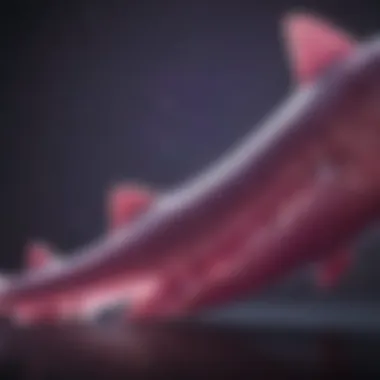Purple Shark Transcription: Genetic Insights Unveiled


Intro
The study of purple shark transcription offers valuable insights into genetic mechanisms that underpin molecular biology. This fascinating area focuses on how genetic expression occurs within this distinct species, shedding light on broader themes of evolution and transcriptional regulation. Here, we will unpack the intricacies of this subject, providing a comprehensive overview of both methodologies and findings.
Research Overview
Understanding purple shark transcription involves delving into its fundamental processes. Transcription refers to the synthesis of RNA from a DNA template, playing a vital role in gene expression. It is crucial to grasp the mechanisms involved in this process, as they govern how genes are activated or silenced.
Methodological Approaches
Research on purple shark transcription adopts various methodologies. High-throughput sequencing techniques, such as RNA-Seq, have become essential in delineating gene expression profiles. These methods allow researchers to quantify RNA presence across vast genomic landscapes efficiently. In addition, bioinformatics tools assist in analyzing large datasets, enabling scientists to uncover patterns in transcriptional regulation specific to purple sharks.
Significance and Implications
Investigating the mechanisms of transcription in purple sharks has considerable implications. It provides insights into evolutionary biology, helping us understand how specific traits have developed and been maintained. Furthermore, these findings may contribute to broader genomic studies across vertebrates, illuminating evolutionary pathways and adaptations.
"Understanding purple shark transcription not only enriches our genomic knowledge but also enhances our grasp of evolutionary trends in species."
Current Trends in Science
The domain of molecular biology is continuously evolving, with emerging trends that shape research agendas.
Innovative Techniques and Tools
Recent advancements include CRISPR-based technologies for gene editing and synthetic biology approaches that aim to manipulate transcriptional pathways. These innovations enable precise experimentation and hold the potential to revolutionize our understanding of gene function and regulation.
Interdisciplinary Connections
The study of purple shark transcription benefits from interdisciplinary collaboration. Insights from evolutionary biology, ecology, and genetics merge to create holistic views of how transcription impacts adaptation and survival. This intersection of disciplines enriches the research landscape and fosters innovative solutions to complex biological questions.
Prelude to Purple Shark Transcription
Transcription, the process through which genetic information from DNA is transferred to messenger RNA, plays a pivotal role in gene expression. Understanding transcription in purple sharks can provide unique insights into evolutionary biology and adaptation. This section outlines the significance of studying purple shark transcription, focusing on mechanisms, regulatory elements, and genetic implications.
Overview of Transcription in Molecular Biology
Transcription is fundamental in molecular biology. During this process, specific segments of DNA are copied into RNA. This transcription mechanism involves several key steps: initiation, elongation, and termination. Each step is crucial for ensuring that the RNA produced accurately reflects the genetic code found in the DNA.
The enzymes, such as RNA polymerase, are essential for driving transcription. Once the RNA strand is synthesized, it undergoes further processing before being translated into proteins. These proteins are vital for cellular functions and overall organismal health. Thus, understanding transcription provides a window into numerous biological processes, from development to response to environmental stresses.
Relevance of Purple Sharks in Genomic Studies
Purple sharks, or Labeo chrysophekadion, are interesting subjects for genomic studies. Their unique adaptations to the aquatic environment make them a valuable model organism. Researchers have identified numerous genetic traits linked to their survival and reproductive mechanisms.
Studying purple shark transcription enhances our understanding of evolutionary processes. It helps illuminate how these sharks adapt to changes in their environment. Furthermore, the insights gained from purple shark genomics are applicable to broader fields, including conservation genetics and biotechnology.
The genomic information about purple sharks can also lead to discoveries about gene regulation, variation in transcription patterns, and how these elements contribute to evolution. As a result, the research on purple shark transcription serves not only as a case study but also as a foundation for understanding transcription mechanisms in other vertebrates.
Mechanisms of Transcription
Understanding the mechanisms of transcription is fundamental for grasping genetic expression in purple sharks. Transcription is where genetic information from DNA is copied to RNA, a critical first step in gene expression. This process does not operate in isolation but is influenced by various factors, including regulatory elements, transcription factors, and the structure of the DNA itself. By studying these mechanisms in purple sharks, researchers shed light on complex biological processes that may have broader implications in the realm of evolutionary biology and genetics.
The transcription process significantly affects how genes are expressed, which can impact everything from physiological traits to behavioral characteristics in organisms. Moreover, transcription mechanisms are crucial in understanding potential adaptations, especially in unique species such as purple sharks where genetic variability can provide insights into evolutionary pressures. Therefore, comprehending the mechanisms of transcription is not merely about understanding a biochemical process but about engaging with the very foundation of biological diversity and evolution.
Transcription Initiation


Transcription initiation is the critical first step in the transcription process. This stage involves the assembly of a complex of proteins that includes the RNA polymerase enzyme, which is responsible for synthesizing RNA from the DNA template. The initiation begins when specific sequences of DNA, known as promoters, are recognized by transcription factors. These factors play a pivotal role in determining which genes are to be expressed at any given time.
The promoter region contains specific motifs that allow transcription factors to bind, thus activating transcription. Once bound, the RNA polymerase enzyme unwinds the DNA strands, creating a transcription bubble. It is important to highlight that different genes have unique promoter sequences, which confer specificity to gene expression. This is particularly evident in purple sharks where specific environmental and physiological adaptations may select for certain transcription factors.
Elongation and Termination Processes
After initiation, elongation begins when RNA polymerase moves along the DNA strand, synthesizing a complementary RNA strand. During this phase, nucleotides are added one by one, elongating the RNA molecule. The process is tightly regulated to ensure proper gene expression levels. Factors such as the speed of RNA polymerase and the presence of elongation factors can significantly affect this phase. In purple sharks, research indicates that variations in the elongation process might correlate with unique adaptations to their environments.
When the elongation phase reaches the end of a gene, the termination process occurs. This phase signals the end of RNA synthesis and occurs when RNA polymerase encounters a specific sequence that triggers a conformational change in the enzyme, leading to disengagement from the DNA template. Understanding this termination mechanism is vital, as it can affect the stability and function of the resulting RNA, ultimately impacting the protein production that follows.
In summary, the mechanisms of transcription, encompassing initiation, elongation, and termination, are vital for regulating genetic expression in purple sharks. Knowledge of these processes not only enhances comprehension of their unique biology but also contributes to broader genetic studies within evolutionary frameworks. Understanding these mechanisms lays the groundwork for exploring the relevance of transcription in various genetic contexts.
Regulatory Elements in Transcription
Understanding regulatory elements in transcription is essential for dissecting gene expression, particularly in purple sharks. These elements govern when, where, and how genes are activated or silenced. Their intricacies help us explore the complexities of the genetic architectures underlying various biological processes. Regulatory elements include promoters and enhancers, which play distinct but complementary roles in modulating transcription.
Promoters and Enhancers
Promoters are DNA sequences located at the start of genes. They serve as the binding site for RNA polymerase, the enzyme responsible for transcribing genes into messenger RNA. The strength of a promoter ensures that transcription occurs efficiently and accurately, influencing the abundance of the corresponding protein.
Enhancers, on the other hand, are distant regulatory sequences that can increase the likelihood of transcription. They can function independently of their position and orientation relative to the target gene. Enhancers often contain binding sites for transcription factors, which are proteins that facilitate or inhibit the recruitment of RNA polymerase to the promoter region. The interaction between enhancers and promoters is crucial for the precise control of gene expression.
Key points regarding promoters and enhancers include:
- Promoters establish a foundation for transcription initiation.
- Enhancers can enhance transcription levels significantly, sometimes up to 100-fold.
- Both elements are tissue-specific, which means different tissues may utilize distinct combinations of these sequences.
The coordination between promoters and enhancers illustrates a sophisticated regulatory network that contributes to the fine-tuning of gene expression in purple sharks, and beyond, providing insights into broader evolutionary and functional aspects.
Transcription Factors
Transcription factors are pivotal in transcription regulation. These proteins bind to specific DNA sequences, facilitating the interaction between DNA and RNA polymerase. Transcription factors operate as activators or repressors, influencing the extent of gene expression.
There are several classes of transcription factors, including:
- General transcription factors, which are necessary for the transcription of all protein-coding genes. These proteins interact with the core promoter to form a transcription initiation complex.
- Specific transcription factors, which bind to enhancer or silencer sequences and regulate gene expression in a context-dependent manner.
- Co-factors that assist in the assembly of transcription complexes but do not directly bind to DNA.
The complexity of transcription factor interactions with regulatory elements shapes the overall landscape of transcription. Understanding how these factors function in purple sharks can shed light on similar mechanisms in other species, providing insights into evolutionary adaptations and conservation efforts.
"Transcription is not just a simple process; it reflects the dynamic interplay between various regulatory elements that can determine the fate of a cell and its overall function."
Future studies focusing on these regulatory elements could enhance our comprehension of genetic mechanisms, particularly in the context of environmental adaptation and species survival.
Genetic Expression and Variation
Understanding genetic expression and variation is essential to grasp how purple sharks adapt and evolve. Genetic expression refers to the process where information from a gene is used to synthesize functional gene products, like proteins. Variation in genetic expression can lead to diverse traits and abilities within a species. Hence, studying these aspects enables researchers to uncover the adaptability of purple sharks in changing environments.
Genetic expression is influenced by several factors, including environmental cues, genetic background, and cellular conditions. For purple sharks, this is particularly significant given their habitat. Their ability to respond to different water conditions, food availability, and predators hinges on how their genes are expressed. Moreover, it illustrates evolutionary processes that enable these sharks to thrive in various ecosystems.
In addition, examining genetic variation allows scientists to understand evolutionary relationships not only within the species but also across different species. For instance, subtle genetic expression changes can have drastic implications for survival and reproductive success. The case of purple sharks illustrates how even minute differences in gene expression patterns can confer competitive advantages in their natural habitats. Such insights contribute to broader understanding of species adaptation and resilience against threats like climate change and habitat loss.
"Genetic variation serves as the raw material for evolution, providing the diversity needed for populations to adapt to changing environments."
Species-Specific Transcription Patterns
Species-specific transcription patterns are a reflection of the unique adaptations that purple sharks have developed over time. These patterns are crucial for understanding how different genes are turned "on" or "off" in response to their environment. Research has shown that purple sharks display distinct transcriptional profiles when compared to other elasmobranchs, which helps highlight their unique evolutionary path.
For example, stress response genes in purple sharks are activated differently than those in other fish species. This can help them cope with specific environmental challenges, such as fluctuations in salinity or temperature. Such distinctive patterns underscore their evolutionary significance within their ecological niche.


Moreover, evaluating these transcription patterns can reveal important insights into the molecular mechanisms governing development, behavior, and physiology in purple sharks.
Implications of Genetic Variation
The implications of genetic variation extend into various fields, including conservation genetics and evolutionary biology. By assessing the degree of genetic variation in purple sharks, researchers can inform conservation efforts aimed at preserving genetic diversity. This is vital since reduced genetic variation can lead to inbreeding and increased vulnerability to diseases.
In terms of evolutionary biology, genetic variation within a species reflects its adaptability to environmental stressors. The purple shark’s genetic flexibility allows it to endure rapidly changing conditions, thereby maintaining its population stability in the long term.
From an applied perspective, understanding genetic variation helps in developing breeding programs for captive populations. This can ensure that genetic diversity is maintained, which is essential for the recovery of endangered species. By looking at the genetic makeup of purple sharks, scientists can employ strategic frameworks to enhance their survival chances in marine ecosystems.
In summary, delving into genetic expression and variation provides significant insights into how purple sharks function and survive in their environments. The consequences of these genetic aspects are far-reaching, offering invaluable information that can be applied to both evolutionary theory and practical conservation strategies.
Comparative Analysis with Other Species
The comparative analysis of transcription mechanisms in purple sharks against other species plays a vital role in understanding evolutionary processes and genetic diversity. This section highlights how such an analysis can reveal insights into the unique transcriptional adaptations that purple sharks have developed. These adaptations can provide clues about the evolutionary pressures that shaped their genome.
Transcription in Elasmobranchs versus Other Fish
Elasmobranchs, which include sharks and rays, have distinct transcription processes when compared to bony fish. This difference is largely due to their unique evolutionary lineage. For instance, the structure of their DNA and chromatin organization can influence the overall transcription efficiency.
Research indicates that certain transcription factors are conserved across species. However, specific factors in purple sharks may allow for greater adaptability to their environments. Understanding these processes could enhance our knowledge of evolutionary biology.
- Transcription differences include:
- Promoter regions: Elasmobranchs often show variations in promoter sequence, affecting gene expression levels.
- Transcription factor usage: Certain factors may be unique to sharks, playing specific roles in stress responses or environmental adaptations.
- RNA processing: The splicing mechanisms can differ significantly between elasmobranchs and bony fish, impacting overall protein synthesis.
Adaptive Significance of Transcription Mechanisms
The adaptive significance of transcription mechanisms cannot be overstated. The ability of a species to thrive hinges on their genetic response to environmental challenges. Purple sharks exhibit transcription mechanisms that may enhance survival in fluctuating habitats, highlighting the importance of studying these processes.
Key points include:
- Response to Stress: Transcriptional changes can be crucial during stress periods, such as temperature fluctuations or pollution.
- Evolutionary Fitness: Effective transcriptional regulation enhances a species' adaptability, improving its chances of survival over generations.
- Ecological Roles: Understanding transcription variability can inform on the ecological roles that purple sharks play within their environments.
"Studying the transcriptional mechanisms in purple sharks and comparing them to other species enhances our understanding of their evolutionary adaptations."
In summary, the comparative analysis provides not only insights into the molecular intricacies of purple sharks but also broader implications for ecological and evolutionary studies. It bridges the gap in knowledge between elasmobranchs and other fish, underlining the evolutionary significance of transcription mechanisms.
Applications of Purple Shark Transcription Research
The study of purple shark transcription holds notable significance across various fields, particularly in biotechnology and conservation. Understanding the genetic mechanisms involved in transcription can lead to advancements in genetic engineering, which has implications for medical and agricultural sectors. Furthermore, insights gained from purple sharks can inform conservation efforts, especially in preserving biodiversity and managing habitats. By examining the processes underlying transcription, researchers can better understand adaptive traits and responses to environmental changes in sharks and other species.
Biotechnology and Genetic Engineering
Transcription is critical in biotechnology, as it directly affects gene expression. The unique genetic properties of purple sharks provide an interesting model for genetic engineering applications. For instance, scientists can explore how specific transcription factors influence traits. This helps in designing experiments that modify genetic expressions for desired outcomes, such as disease resistance in crops or enhanced growth rates in aquaculture species.
Additionally, purple sharks can serve as a model organism to study gene responses to various stimuli. By manipulating transcriptional activity, researchers can investigate how beneficial genes can be activated in other organisms or even humans. This research could pave the way for breakthroughs in gene therapy, where defective genes are corrected or replaced.
Conservation Genetics
Conservation genetics focuses on preserving genetic diversity within species. Purple sharks, with their distinct transcription profiles, are crucial for understanding how organisms adapt to changing environments. By researching their transcription mechanisms, scientists can identify genetic variations that allow for resilience against environmental stresses.
For example, understanding how purple sharks regulate their genes under stress can help form conservation strategies for endangered species. It allows conservationists to pinpoint essential genetic markers that sustain populations in adverse conditions. Proper application of these insights in wildlife management can enhance efforts in conserving not only sharks but various marine species facing extinction due to habitat loss and climate change.
Conservation genetics helps maintain biodiversity and adapt to new conditions. The insights from purple shark research contribute significantly to these goals.


Current Trends in Transcription Research
Current trends in transcription research are reshaping our understanding of gene expression and providing new avenues for exploration. This section discusses the significance of these trends, focusing particularly on two pivotal areas: emerging technologies and the integration of bioinformatics. Both aspects have the potential to revolutionize how we analyze transcription processes, making it essential for students, researchers, and professionals in genetics and molecular biology.
Emerging Technologies in Gene Expression Analysis
Recent advancements in technologies have greatly enhanced the way gene expression is analyzed. Techniques like CRISPR-Cas9 and RNA sequencing are now at the forefront. These technologies allow for precise modifications in gene sequences and enable detailed profiling of RNA transcripts. The power of single-cell RNA sequencing is particularly noteworthy. It illuminates the variations in gene expression at the individual cell level, making it possible to discover subtle transcriptional differences that previous methods could not detect.
- CRISPR-Cas9: This gene-editing tool allows researchers to make specific changes in the genome, facilitating targeted studies on transcription regulation.
- RNA Sequencing: This technique provides a comprehensive view of the transcriptome, revealing which genes are active, to what extent, and under various conditions.
These emerging technologies offer numerous benefits, such as increased accuracy and the ability to perform high-throughput analysis. Researchers can analyze large datasets rapidly, which accelerates discoveries in gene function and regulation. The insights gained can eventually lead to improvements in fields such as biomedicine and environmental science.
Integration of Bioinformatics in Transcription Studies
Bioinformatics plays a critical role in transcription research today. With the exponential growth of data from genomic studies, there is a pressing need for sophisticated analytical tools. Integrating bioinformatics with traditional laboratory techniques aids in managing and interpreting large datasets effectively.
- Analysis of Big Data: Advanced algorithms and software tools are used to analyze complex biological data, facilitating the identification of transcription patterns and regulatory elements.
- Predictive Modeling: Bioinformatics allows researchers to build predictive models that can forecast transcriptional responses to genetic changes or environmental factors.
Collaboration between molecular biology and computational science is essential. Such integration fosters a holistic approach, ensuring that research results are validated and understood within a broader genomic context. It also paves the way for developing new hypotheses about transcription that can be tested experimentally.
"Incorporating bioinformatics into transcription studies transforms how researchers approach genetic mechanisms. It enhances the capacity to uncover relationships between transcription factors and gene expression."
In summary, staying abreast of current trends in transcription research, particularly emerging technologies and bioinformatics integration, empowers researchers to advance their understanding of gene expression. These advancements not only contribute to academic knowledge but also have practical implications in health, conservation, and biotechnology.
Future Directions in Purple Shark Transcription
The study of purple shark transcription opens up many potential opportunities for understanding genetics and evolution. As researchers continue to uncover the essential mechanisms behind transcription processes, gaining insights into how specific genetic expressions occur in purple sharks becomes crucial. The significance of this research extends beyond just one species; it can illuminate understanding of vertebrate evolution and adaptation.
Potential Areas for Further Research
There are numerous areas within purple shark transcription that require further investigation. Some key aspects include:
- Functional Analysis of Regulatory Elements: Exploring how specific promoters and enhancers affect gene expression will provide insight into transcription regulation. This can help identify critical genetic pathways while also revealing their evolutionary significance.
- Comparative Genomics: Comparing transcription mechanisms in purple sharks to closely related species like other elasmobranchs may elucidate unique adaptations. Understanding genetic differences across species can help clarify evolutionary processes.
- Impact of Environmental Factors: Investigating how environmental changes affect transcriptional responses in purple sharks may provide essential context for conservation strategies. Monitoring gene expression in varying conditions can help assess resilience to environmental stressors.
Each of these areas contributes to a cohesive understanding of genetic transcription and its implications both for purple sharks and broader biological principles.
Collaborative Projects Across Disciplines
In future research, a multifaceted approach will enhance the understanding of purple shark transcription. Collaboration across disciplines can lead to breakthroughs. Some collaborative opportunities include:
- Integrating Molecular Biology with Ecology: Combining genetic research with ecological studies can identify how transcriptional changes influence ecological interactions and adaptation.
- Partnerships with Bioinformatics Experts: Using computational tools to analyze genetic data can streamline the identification of transcription factors and regulatory elements effectively.
- Engagement with Conservation Genetics: Working closely with conservationists can lead to actionable strategies based on transcription research to help preserve purple sharks and their habitats.
The interplay between various disciplines fosters innovation, creating a more comprehensive understanding of the genetic mechanisms at play in purple shark transcription and their implications for broader biological questions.
Future directions in purple shark transcription not only promise to advance scientific knowledge but also offer practical applications in conservation and biotechnology, demonstrating the value of continued investment in this area of research.
End
Understanding the genetic mechanisms of purple shark transcription holds significant importance in molecular biology. This article highlights various specific elements that contribute to our knowledge of transcription processes, offering insights into evolutionary biology and genetics. The complexities of gene expression in purple sharks serve as a valuable model for understanding broader biological principles across species.
Summary of Key Insights
The detailed examination of transcription mechanisms reveals several key insights:
- Transcription Initiation: The initiation phase marks an essential starting point in the gene expression process. It involves several components, including transcription factors and promoter regions that set the tone for genetic expression.
- Regulatory Elements: The role of enhancers and repressors cannot be overstated. These elements control when and how genes are expressed, ensuring that transcription occurs in a highly regulated manner.
- Species-Specific Patterns: The unique transcription patterns found in purple sharks illuminate how genetic expression varies among different species, allowing researchers to understand evolutionary adaptations better.
- Applications in Research: Insights gained from studying purple shark transcription influence biotechnology, genetic engineering, and conservation endeavors. This adds practical value to the scientific community's efforts in these domains.
Final Thoughts on the Importance of Transcription Studies
The ongoing research in transcription studies is vital for several reasons:
- Understanding Genetic Variations: It provides insight into how genetic differences affect various biological functions, which is essential for fields like medicine and conservation biology.
- Technological Advancements: Emerging technologies in gene expression analysis create opportunities for new discoveries. As techniques improve, so does our ability to dissect and understand intricate genetic networks.
- Interdisciplinary Collaboration: The topic encourages collaborative research efforts across biological, computational, and environmental disciplines. This multifaceted approach enhances our understanding of genetic mechanisms and their implications across various sectors.
By synthesizing the knowledge presented in this article, it becomes clear that studying purple shark transcription is not merely an academic endeavor; it is a gateway to understanding the fabric of life and its myriad expressions. Engaging with this research will undoubtedly shape future advancements in molecular biology and genetics.



